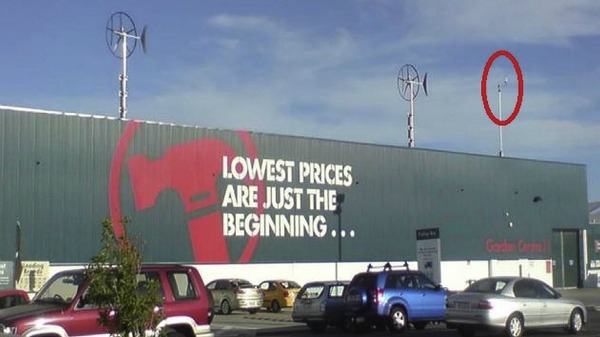This article, from ScienceNetwork WA, is authored by Cristy Burne.
Increasingly popular as a source of renewable energy, SWTs are designed using a turbulence model developed for open terrain, but research by Murdoch University PhD candidate Amir Bashirzadeh Tabrizi suggests this can be an expensive mistake. “This model underestimates turbulence in the built environment,” he says.

The front of the Bunnings warehouse in Austrailia shows two of five small wind turbines and the ultrasonic anemometer position (red circle).
Tabrizi’s research suggests rooftop wind gusts can reduce the output and working life of SWTs designed for open fields. “When manufacturers design machines expecting less turbulence, they predict the machine will work for 15 years, but in the built environment, after five, six, seven years, the machine fails. In the real world, the machine experiences more turbulence, and as a result, more fatigue loading.”
Tabrizi analysed two years of data gathered from five one-kilowatt SWTs located on the rooftop of the Bunnings warehouse at Port Kennedy, determining how the turbines’ location affected rooftop turbulence. “When you put turbines in the right place, it’s free energy. If you put them in the wrong place, you waste your money,” he says.
“Many people thought the edge of the roof is a good place to put a machine, but our research shows the middle is the best place. When you put a machine on the edge of the roof, the vertical component of the wind is higher, and the vertical component is really bad in terms of fatigue loading.”
Tabrizi found calculations of turbulence intensity were affected by the interval over which wind measurements were averaged. “The averaging period has a big impact on the results. If designers use data averaged over one minute, they predict the machines will experience turbulence intensities of around 18 to 20%, but in the real world, the machine experiences around 25 to 30%.”
Tabrizi suggests averaging data over ten minutes to conservatively estimate the intensity of rooftop conditions. He also suggests measuring wind conditions once per second is enough to most turbulence effects. “Our research shows it doesn’t matter if you’re using 1 Hz or 10 Hz data, which is really good. If you want 10 Hz data, you need sonic instruments, and they’re not cheap. But for 1Hz data, you can use a cup anemometer, and they’re much, much cheaper,” he says.
Results from the Murdoch University study will be used by the International Energy Agency to develop recommended guidelines for wind turbine installation in built environments.
Filed Under: News




